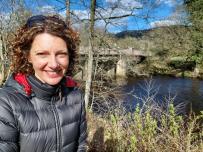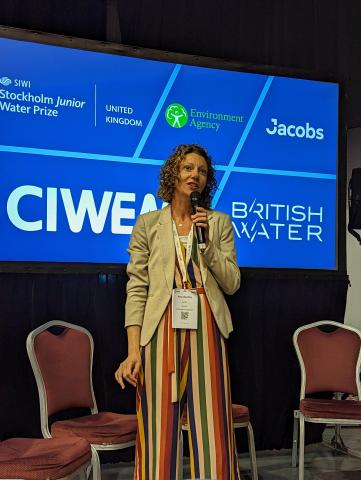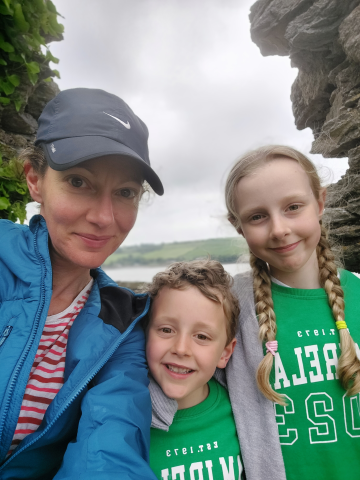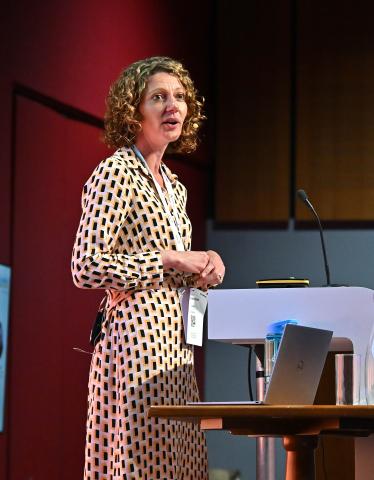Meet Amy Bentley
Leeds, England, U.K.

Amy Bentley is an award-winning, pioneering leader in the water and environment sectors, and she brings her signature style of inclusive and inspirational leadership, a blend of hard and humanistic skills and a curious mindset that challenges traditional thinking and conventional approaches.
Amy’s market-leading teams rely on diverse skills and backgrounds, united with a common goal — to harness cross-sector capabilities and data-driven insights to create breakthrough solutions founded on nature, design and technology.
Curiosity, empathy and a growth mindset are arguably the most powerful qualities in a leader. Amy’s career progression has relied on all three. After doing a geography degree and a master's degree in water resources management at the University of Leeds, Amy started her career as a hydrologist. Amy spent the next four years specializing in technical work in flood hydrology, such as flood risk mapping and catchment management plans, mainly for the Environment Agency as a client.
“I absorb energy from others, and I’m driven to create positive interactions that make working life easier by removing obstacles and friction, making connections and ramping up collaboration. When that happens collectively, our projects thrive and our clients excel.”
In 2007, Amy wanted to travel, and her adventures led her to Australia. After three years, she transitioned from technical work to project and operational management through her natural leadership ability. With guidance from key mentors, Amy successfully led teams in water resources and environmental planning. In 2016, Amy returned to the U.K. and joined Jacobs to lead the Birmingham team for rivers, coastal and water environments. Over time, Amy embraced various roles, from operational sales to head of water catchment management. It all led up to her current role as the head of sector in water and environment for Europe.
Now her leadership skills, experience and technical expertise are being used to solve her sector’s biggest challenges. There's incredible growth and investment in the water and environment sectors, and it’s combined with raised sector recognition due to the climate and biodiversity crises.
Amy’s teams are helping our clients tackle these challenges and reach net zero by 2030 by focusing on critical areas such as improving combined sewer overflows (CSOs) and driving the return on investment in technology and talent. Amy is supporting our clients while growing her teams’ broad church of services, and she’s ensuring we attract and retain the most talented, innovative employees — just like the curious, adventurous hydrologist graduate from Leeds.
Get to know Amy
How are you helping to solve our clients' biggest challenges?
Their biggest challenges are dealing with climate change, extreme conditions and sustainability. There are several ways in which we’re supporting our clients. The first one is through our strategic resource options (SROs) major water programs. Some of the work we're doing with our water clients, like Anglian Water and Thames Water, looks at how you can move water from across different regions of the country to ensure water supply resilience. That covers major project delivery to build reservoirs, storage and connections sustainably.
The second way is with the critical CSOs. We’re using technology and design to drive better results, including solutions that can be integrated quickly and offer consistent sector savings. Within this, we’re also working with exciting tools and materials, such as low-carbon concrete, to help reduce carbon costs for our clients. This is all part of our effort to help them achieve their net zero targets and future resilience. We’re challenging traditional methods of delivery across our industry and providing more nature-based solutions, such as Low Crosby in the North West of England.
We’re also working with clients and partners to challenge how they operate from a health, safety and environment point of view. How do we drive productivity and growth safely through our workflows? How do we use a project approach that covers flood risk and offers sustainable drainage and land usage?
To solve all these client challenges, we need to connect the dots and use cross-sector talent and technology instead of focusing on managing specific challenges in isolation, like CSOs, water transport or resilient supply. Instead, we need to look holistically at whole sectors and across markets to create unified solutions.
For example, one of our most critical focuses is addressing the talent and resource shortage across our industry. The Water Academy is a part of our solution; it’s an internal two-week accelerated program that brings in colleagues from other sectors. Participants drive conversation and action around transferable skills, inclusion and diversity. Along with our continued drive to retrain and upskill our staff, it provides a brilliant opportunity for employees to have an agile career within Jacobs.
The success of my role relies on working as an integrator and connector, as we bring in different capabilities and industry lessons across markets and sectors and use nature, design and technology to create the right solutions.
Managing all these moving parts creates my biggest challenge and greatest joy. I’ve always enjoyed the diversity and the deep understanding needed along with the demand to deliver differently now with a digital, sustainability and social value lens. We are resource-constrained, so collaboration and standing up new technologies are integral for our collective industry success. River catchments don't stick to political boundaries, so we must move past agendas and individual goals to work together for the betterment of our communities, clients and the industry.
What are the leadership lessons you've learned so far?
- The greater the goals, the more difficult the decision-making becomes.
Making difficult decisions becomes more common and nuanced when trying to grow a business sustainably and ethically — the easiest choices usually aren’t the correct ones. I’ve learned just how critical it is to try to be as approachable, honest and authentic as possible when making those choices. - You will never have all the answers.
I’ve learned it’s vital to show vulnerability by saying I don’t know the answer, asking for support or trying to understand something better. It also helps to get other people on my team to share their ideas and experiences to create diversity of thought. It works for all relationships, not just with your line manager. - Keep explaining the ‘why’ behind decisions.
In a company with our scale and complexity, it’s relatively easy for our colleagues not to understand why we do certain things. This is where transparency is critical. It also translates into actions, such as advertising internal roles. It builds a stronger sense of trust if you can be transparent in your actions and visible in your reasoning. - Aim for diversity in different forms.
While gender diversity is incredibly important and is something I actively promote within our industry, it goes beyond that. Gender diversity is arguably one of the more accessible areas to measure and monitor, but there are many more areas to include, such as diversity of thought, experience and background. Shifting your mindset to consider more of those areas when actively recruiting and mentoring can help drive inclusion, positive change and better team performance. - Adapt and adjust.
Now that I’m further along in my career, I’ve recognized that how I work and think has changed. I have a young family and must work flexibly so I can do my job and be there for my husband and children. Taking a flexible approach has been fundamental in juggling this and something that I’ve learned to get better at over time! It has also driven me to work in different ways and to pull in my team and think carefully about how I use my time. A key part of it is establishing boundaries early — it makes me constantly prioritize and challenge how others can support me and grow through the experience. I also ensure I get some time to myself to step back and reflect. - Building a value-driven culture starts by honoring the right values.
Talking about the values is just the start; success relies on your actions reinforcing the values. For example, our culture of care and safety. It involves constantly speaking to people, making yourself available, and genuinely celebrating when you see those values at work. This is where you can use internal praise and impact bonuses to celebrate these actions and catalyze more positive action. These values need to be reinforced by you both exhibiting the right actions and celebrating when others do it. - Coaching and mentoring offer opportunities for learning and testing.
I’m grateful to have several mentees I use for reverse mentoring and learning opportunities. I share ideas with them to get their opinions before implementing them. I also have coaches who have helped me personally and I have been coached as part of a group. That provides more insight into your management and leadership style, reveals what you do well and helps identify your blind spots. One of my takeouts is that we all tend to be over-critical of what we perceive we don't do well rather than having a more balanced approach that considers our overall impact and focuses on our strengths.
-
10
concert performances of Handel’s Messiah Amy has participated in
-
20
months of parental leave taken when Amy had her two children
-
2.5 K
staff Amy leads across multiple disciplines
How would you describe your personal motivation in the work you do?
I want to create a better world for my children and their generation and positively impact the people I work with. That’s much easier to say than do, but I'm genuinely focused on doing things more effectively and responsibly in the projects I lead, my relationships, and, critically, the people I mentor. Seeing mentees and colleagues thrive gives me the most satisfaction.
So, in short, having a positive, empowering impact on people and constantly improving are what motivates me.
What would people be most surprised to find out about you?
Some of my colleagues know this, but I’m a choral singer. I sang with the Sydney Philharmonic Choir in the Sydney Opera House and surrounding locations for many years. As a choir, we toured to London and opened the first night of the Proms at the Royal Albert Hall. So that’s probably my secret talent and most surprising detail all rolled into one!















































